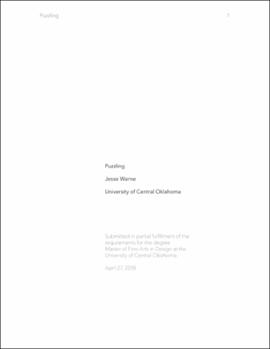| dc.description.abstract | Our interactions with letterforms are ever-increasing with the additions of new technologies and a more digitally connected society. Through stone tablets to papyrus scrolls, printed books to digital publishing, type finds new ways to reach our eyes. From the moment we wake up to the numbers and letters on our alarm clocks until the credits roll on the last show we watch before turning off the television to go to bed, typography follows us through nearly every moment of our day. Some instances maintain the formality of strict typographic usage while others exhibit an informality (although no less communicative) that feels almost primal. The way people interact with letterforms is constantly evolving, and typographers need to actively engage in exploring new approaches to type design and typesetting. This body of work serves as evidence of my human experience and the processes and methods of its creation serve as evidence of potential in future directions in letterform design. While many working designers spend their professional days filling boxes with text, this work has been more inspired by designers who have disregarded the box, placed their box on the side of a subway car or used the box to chop text into pieces and start anew. Editorial designer David Carson, artist Augustine Kofie, and letterpress abstractionist David Wolske have all influenced my thesis work. Carson's approach to communication opened a path to more creative exploration in how typography can be used to greater effect by breaking rules than by following them. Kofie's letterform inspires geometric shapes showed me that even the simplest of forms are capable of a powerful and dynamic aesthetic. Finally, Wolske's approach to utilizing older technologies in new ways demonstrated to me that there is much to be explored and drawn out of even the oldest of design tools.As designing type has migrated to the digital realm over the last several decades, type designers have lost a physical connection to their work. In addition, letterforms and type systems have been constrained to the limitations of software and display systems. In order to bring letterform creation back into the hands of the designer, both literally and figuratively, I used a laser engraving machine to create a system of modular wood pieces with a wide variety of straight edges, curves, and diagonals that can be placed on a base in the bed of a cylinder letterpress. This modular system allows me to physically construct letterforms in the same environment in which they will be applied. The tangible artifacts that I created and interacted with over and over again taught me about the nature of certain materials and the wants and needs of inanimate objects. The act of creating all of these pieces of dissected letterforms that I could work with in the physical space of the press bed allowed me to gain a much closer relationship with and understanding of letterform design than I feel I could have gained behind the barriers of a digital screen and keyboard. Although the pieces of the system were initially designed to work on a specific grid ratio, experimentation proved the ability to vary both the ratio and scale of the pieces. This allowed for greater variety and fostered creativity in the letterform design process. This project spans the full cycle of deconstruction to creation. Beginning with the examination of the existing typographic landscape and the current practices in type design, I transitioned into exploration of how shapes form into symbols that can communicate information and aesthetic expression. By breaking down letterforms into their most basic geometric shapes I was able to establish a system of physical exploration that not only enables but promotes tangible interaction in the type design process. With the use of the letterpress as the vehicle for output the process has an association with the origins of modern typographic communication built into it, providing context for past and future directions in type design. Through the exhibition of the body of work in the environment in which it was created, I was able to demonstrate the mechanics of the system, the flexible nature of the process, and the potential for the final printed work to communicate and engage with society. The thesis project and exhibition were titled Puzzling to address the complexity of visual communication and the exertion over the solution for a new approach to modular type design and typesetting. | |
